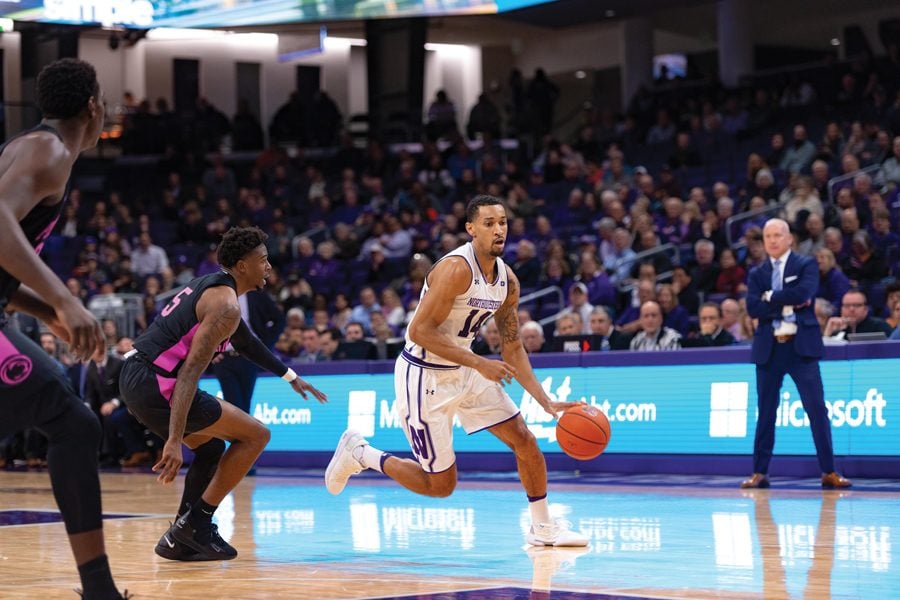Goldsmith: What’s the reason for Northwestern’s 2019 slide?
Daily file photo by Noah Fricks-Alofs
Ryan Taylor dribbles the ball. After transferring twice, the guard averages 11.6 points in his only season at Northwestern.
February 13, 2019
Ryan Taylor didn’t come to Northwestern to lose basketball games.
He played in the Missouri Valley Conference last season, but the Wildcats are on pace to have a worse record than Taylor’s Evansville team did in 2017-18.
After falling to 12th place in the conference standings, this is the reality for NU (12-11, 3-9 Big Ten): The team hasn’t won as much as the coaches promised. The five new players haven’t met expectations that were probably unrealistic, and it’s hard to find someone who’d argue that this season has gone according to plan.
Heading into the year, opposing Big Ten coaches were more curious than intimidated by the Cats. The intrigue stemmed from the fresh faces, including several that were heavily recruited by other coaches in the conference. Indiana coveted Taylor, a native of the Hoosier State. Freshman forward Pete Nance picked NU over Michigan. Tom Izzo recruited junior forward A.J. Turner.
On the other side, there’s coach Chris Collins, now in his sixth season at the helm. All five of this year’s incoming players, plus redshirt Ryan Young, committed after NU’s 2017 NCAA Tournament appearance. Unlike last season, the Cats’ record this year isn’t connected to the aftermath of their 2017 run — it’s a consequence of how long it took to get there.
Among the high school graduates NU recruited between 2015 and 2017, only three have started double-digit games in Evanston — Dererk Pardon, Aaron Falzon and Anthony Gaines.
Forward Rapolas Ivanauskas and guard Isiah Brown transferred this spring before playing significant minutes, and junior center Barret Benson has never scored in double-digits in a Big Ten game. Before suffering a season-ending injury earlier this year, senior guard Jordan Ash never earned a consistent role in the rotation.
It’s not that Collins and his staff made an individual mistake on the recruiting path that set the program back. In Evanston, there are no tales of picking Bowie over Jordan. But there is an opportunity cost that’s beginning to haunt NU.
It’s February, and NU lacks a starting point guard, 3-point shooting and playmaking on the perimeter. There is nothing that can be done to immediately right the ship. Against Iowa on Sunday, Collins started centers Pardon and Benson together. That’s as wacky, and also desperate, as it gets.
In a difficult season of his own in the 1990s, legendary NCAA coach Skip Prosser was asked by a reporter why he wasn’t able to instigate a significant improvement for his team. Prosser’s response was an instant classic.
“I play the players I’ve got.”
You don’t make trades in the NCAA. As Rick Pitino once said, “Larry Bird is not walking through that door.” A prototypical point guard isn’t, either.
That door closed for the Cats when the freshmen came to campus in September. After finishing 15-17 last season, they added the highest-rated recruiting class Collins had ever signed at NU, including Nance, Young, forward Miller Kopp and guard Ryan Greer.
Before contracting mono and being ruled out indefinitely by the team, Nance struggled to earn minutes in close games for NU. Ranked as the No. 85 player in the Class of 2018, Nance is averaging 3.4 points and 1.6 rebounds 18 games into his career, and he’s shooting 28.1 percent from beyond the arc.
Kopp has started 16 games this season, but the No. 113 player in the Class of 2018 had his role lessened once conference play began. He’s averaging less than five points per game. In 10 minutes per outing, Greer averages less than a bucket. Young redshirted the season.
As for the transfers, Taylor has added a much-needed aggressiveness to a struggling offense. But of all the players in power conferences who take as many threes per game as Taylor, only one has a worse 3-point shooting percentage.
While Turner shoots much less frequently than Taylor, he’s even less efficient, scoring 8.3 points per game on an average of seven shots. Neither Taylor nor Turner has scored over 16 points in a Big Ten game.
Ironically, NU’s leading scorer shouldn’t even be here. Senior forward Vic Law redshirted his second season on campus, and had he graduated with his recruiting class last season, the Cats would be down their best perimeter defender, who also happens to score 15.4 points a game.
There have been two waves of players following the McIntosh-Lindsey-Skelly-Law recruiting class of 2014. The pre-tournament recruits and the post-tournament recruits. So far, one group hasn’t outperformed the other.
And then there’s the third group to potentially place blame upon — Chris Collins and the coaching staff. In the slice of life between 2017’s NCAA Tournament berth and the 2018 opening of Welsh-Ryan Arena, Collins spoke of promises, expectations and a new normal. So far this year, that hasn’t been delivered.
While the incoming freshmen for next year have already been signed, the Cats are expected to be active on the graduate transfer market again this spring as over 60 percent of the team’s scoring is graduating. But Collins’ selling points to transfers, as well as the class of 2020, are growing weaker as success becomes a more distant reality.
With nine games to go before the Big Ten Tournament, NU is stuck between a rock and a hard place. The coaches as well as the players — old and new — might not be able to do anything other than decide who the rock will hit first.
Email: charliegoldsmith2021@u.northwestern.edu
Twitter: @2021_charlie



